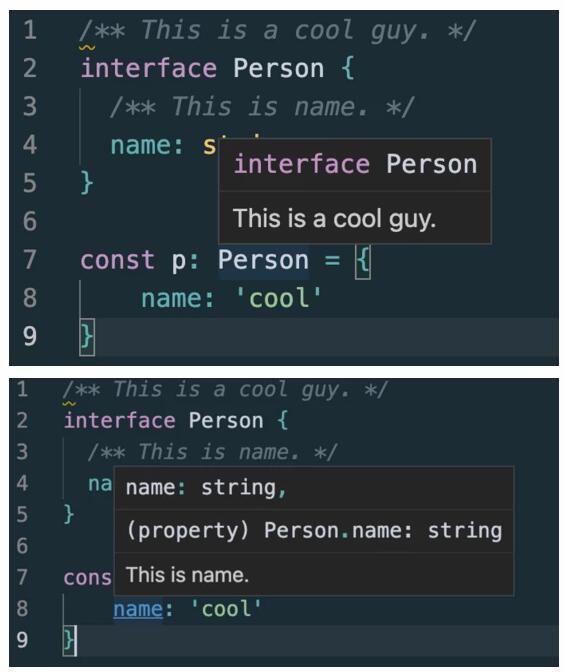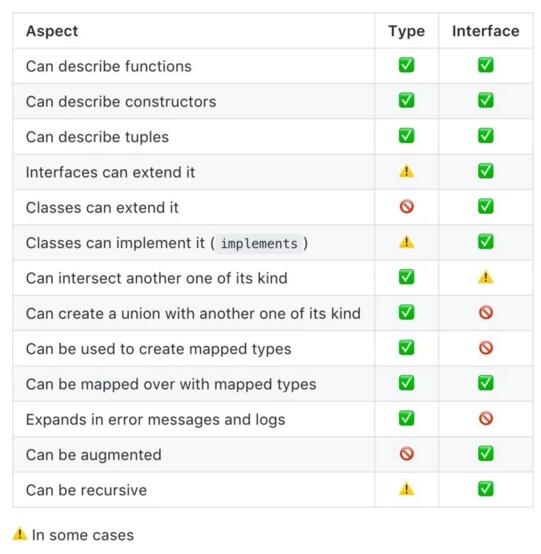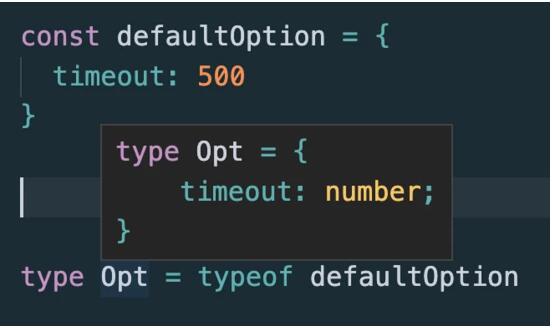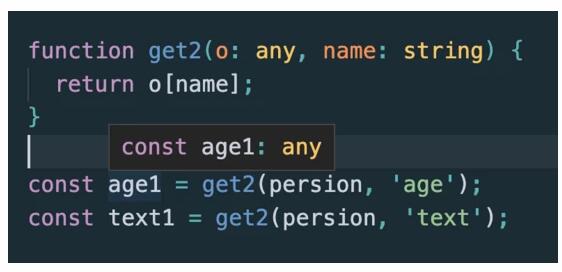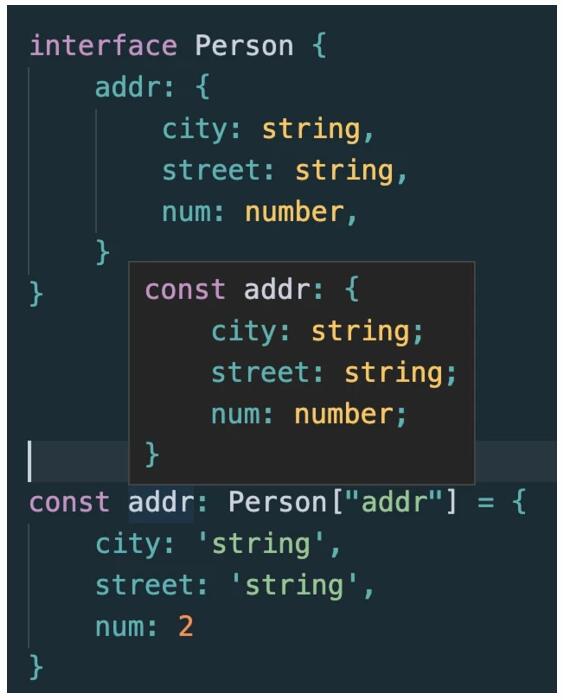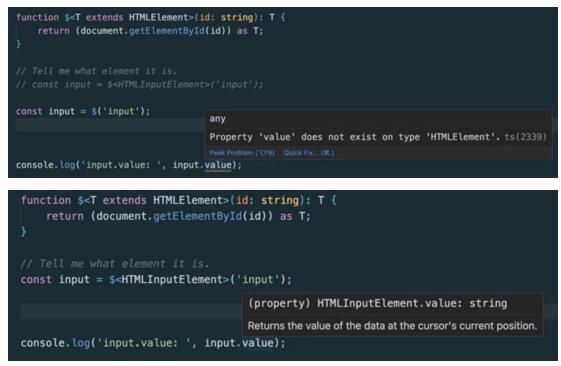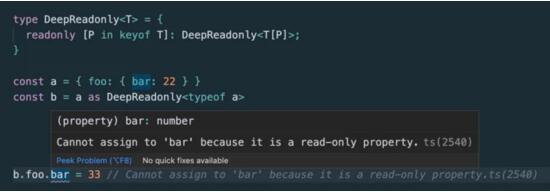TypeScript 中提升幸福感的 10 個高級技巧
用了一年時間的 TypeScript 了,項目中用到的技術是 Vue + TypeScript 的,深感中大型項目中 TypeScript 的必要性,特別是生命周期比較長的大型項目中更應該使用 TypeScript。
以下是我在工作中總結到的經常會用到的 TypeScript 技巧。
1. 注釋
通過 /** */ 形式的注釋可以給 TS 類型做標記提示,編輯器會有更好的提示:
- /** This is a cool guy. */
- interface Person {
- /** This is name. */
- name: string,
- }
- const p: Person = {
- name: 'cool'
- }
如果想給某個屬性添加注釋說明或者友好提示,這種是很好的方式了。
2. 接口繼承
和類一樣,接口也可以相互繼承。
這讓我們能夠從一個接口里復制成員到另一個接口里,可以更靈活地將接口分割到可重用的模塊里。
- interface Shape {
- color: string;
- }
- interface Square extends Shape {
- sideLength: number;
- }
- let square = <Square>{};
- square.color = "blue";
- square.sideLength = 10;
一個接口可以繼承多個接口,創建出多個接口的合成接口。
- interface Shape {
- color: string;
- }
- interface PenStroke {
- penWidth: number;
- }
- interface Square extends Shape, PenStroke {
- sideLength: number;
- }
- let square = <Square>{};
- square.color = "blue";
- square.sideLength = 10;
- square.penWidth = 5.0;
3. interface & type
TypeScript 中定義類型的兩種方式:接口(interface)和 類型別名(type alias)。
比如下面的 Interface 和 Type alias 的例子中,除了語法,意思是一樣的:
Interface
- interface Point {
- x: number;
- y: number;
- }
- interface SetPoint {
- (x: number, y: number): void;
- }
Type alias
- type Point = {
- x: number;
- y: number;
- };
- type SetPoint = (x: number, y: number) => void;
而且兩者都可以擴展,但是語法有所不同。此外,請注意,接口和類型別名不是互斥的。接口可以擴展類型別名,反之亦然。
Interface extends interface
- interface PartialPointX { x: number; }
- interface Point extends PartialPointX { y: number; }
Type alias extends type alias
- type PartialPointX = { x: number; };
- type Point = PartialPointX & { y: number; };
Interface extends type alias
- type PartialPointX = { x: number; };
- interface Point extends PartialPointX { y: number; }
Type alias extends interface
- interface PartialPointX { x: number; }
- type Point = PartialPointX & { y: number; };
它們的差別可以看下面這圖或者看 TypeScript: Interfaces vs Types 。
所以檙想巧用 interface & type 還是不簡單的。
如果不知道用什么,記住:能用 interface 實現,就用 interface , 如果不能就用 type 。
4. typeof
typeof 操作符可以用來獲取一個變量或對象的類型。
我們一般先定義類型,再使用:
- interface Opt {
- timeout: number
- }
- const defaultOption: Opt = {
- timeout: 500
- }
有時候可以反過來:
- const defaultOption = {
- timeout: 500
- }
- type Opt = typeof defaultOption
當一個 interface 總有一個字面量初始值時,可以考慮這種寫法以減少重復代碼,至少減少了兩行代碼是吧,哈哈~
5. keyof
TypeScript 允許我們遍歷某種類型的屬性,并通過 keyof 操作符提取其屬性的名稱。
keyof 操作符是在 TypeScript 2.1 版本引入的,該操作符可以用于獲取某種類型的所有鍵,其返回類型是聯合類型。
keyof 與 Object.keys 略有相似,只不過 keyof 取 interface 的鍵。
- const persion = {
- age: 3,
- text: 'hello world'
- }
- // type keys = "age" | "text"
- type keys = keyof Point;
寫一個方法獲取對象里面的屬性值時,一般人可能會這么寫
- function get1(o: object, name: string) {
- return o[name];
- }
- const age1 = get1(persion, 'age');
- const text1 = get1(persion, 'text');
但是會提示報錯
因為 object 里面沒有事先聲明的 key。
當然如果把 o: object 修改為 o: any 就不會報錯了,但是獲取到的值就沒有類型了,也變成 any 了。
這時可以使用 keyof 來加強 get 函數的類型功能,有興趣的同學可以看看 _.get 的 type 標記以及實現
- function get<T extends object, K extends keyof T>(o: T, name: K): T[K] {
- return o[name]
- }
6. 查找類型
- interface Person {
- addr: {
- city: string,
- street: string,
- num: number,
- }
- }
當需要使用 addr 的類型時,除了把類型提出來
- interface Address {
- city: string,
- street: string,
- num: number,
- }
- interface Person {
- addr: Address,
- }
還可以
- Person["addr"] // This is Address.
比如:
- const addr: Person["addr"] = {
- city: 'string',
- street: 'string',
- num: 2
- }
有些場合后者會讓代碼更整潔、易讀。
7. 查找類型 + 泛型 + keyof
泛型(Generics)是指在定義函數、接口或類的時候,不預先指定具體的類型,而在使用的時候再指定類型的一種特性。
- interface API {
- '/user': { name: string },
- '/menu': { foods: string[] }
- }
- const get = <URL extends keyof API>(url: URL): Promise<API[URL]> => {
- return fetch(url).then(res => res.json());
- }
- get('');
- get('/menu').then(user => user.foods);
8. 類型斷言
Vue 組件里面經常會用到 ref 來獲取子組件的屬性或者方法,但是往往都推斷不出來有啥屬性與方法,還會報錯。
子組件:
- <script lang="ts">
- import { Options, Vue } from "vue-class-component";
- @Options({
- props: {
- msg: String,
- },
- })
- export default class HelloWorld extends Vue {
- msg!: string;
- }
- </script>
父組件:
- <template>
- <div class="home">
- <HelloWorld
- ref="helloRef"
- msg="Welcome to Your Vue.js + TypeScript App"
- />
- </div>
- </template>
- <script lang="ts">
- import { Options, Vue } from "vue-class-component";
- import HelloWorld from "@/components/HelloWorld.vue"; // @ is an alias to /src
- @Options({
- components: {
- HelloWorld,
- },
- })
- export default class Home extends Vue {
- print() {
- const helloRef = this.$refs.helloRef;
- console.log("helloRef.msg: ", helloRef.msg);
- }
- mounted() {
- this.print();
- }
- }
- </script>
因為 this.$refs.helloRef 是未知的類型,會報錯誤提示:
做個類型斷言即可:
- print() {
- // const helloRef = this.$refs.helloRef;
- const helloRef = this.$refs.helloRef as any;
- console.log("helloRef.msg: ", helloRef.msg); // helloRef.msg: Welcome to Your Vue.js + TypeScript App
- }
但是類型斷言為 any 時是不好的,如果知道具體的類型,寫具體的類型才好,不然引入 TypeScript 冒似沒什么意義了。
9. 顯式泛型
$('button') 是個 DOM 元素選擇器,可是返回值的類型是運行時才能確定的,除了返回 any ,還可以
- function $<T extends HTMLElement>(id: string): T {
- return (document.getElementById(id)) as T;
- }
- // 不確定 input 的類型
- // const input = $('input');
- // Tell me what element it is.
- const input = $<HTMLInputElement>('input');
- console.log('input.value: ', input.value);
函數泛型不一定非得自動推導出類型,有時候顯式指定類型就好。
10. DeepReadonly
被 readonly 標記的屬性只能在聲明時或類的構造函數中賦值。
之后將不可改(即只讀屬性),否則會拋出 TS2540 錯誤。
與 ES6 中的 const 很相似,但 readonly 只能用在類(TS 里也可以是接口)中的屬性上,相當于一個只有 getter 沒有 setter 的屬性的語法糖。
下面實現一個深度聲明 readonly 的類型:
- type DeepReadonly<T> = {
- readonly [P in keyof T]: DeepReadonly<T[P]>;
- }
- const a = { foo: { bar: 22 } }
- const b = a as DeepReadonly<typeof a>
- b.foo.bar = 33 // Cannot assign to 'bar' because it is a read-only property.ts(2540)














